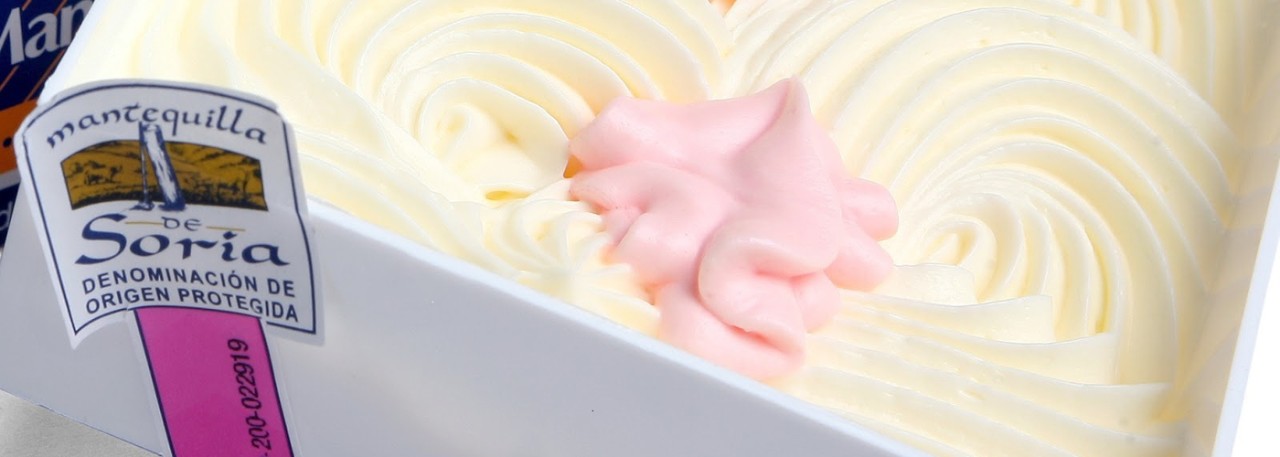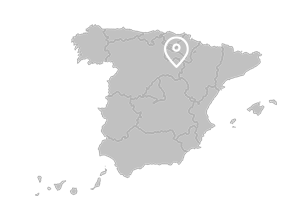.png.transform/rendition-xs/image_image%20(1).png)
Mantequilla de Soria
Butter obtained by pasteurizing the cream from the milk of Friesian and Swiss Brown cows or crossbreeds of the two, from dairy farms in the province of Soria (Castile-Leon).
Tasting notes
-Natural butter: light to medium aroma of diacetyl and fresh cream and very slight acid flavor with moderate persistence. In the mouth it melts moderately fast and has medium viscosity.
-Salted butter: aroma of lightly ripened cream and intense salty flavor with a short aftertaste. In the mouth, it melts moderately fast and has medium viscosity.
-Sweetened butter: aroma of diacetyl and cream, slightly grassy, with a touch of caramelized sugar. Intense sweet flavor, slight acidity and moderate to long persistence. Melts in the mouth medium-fast to fast, and medium viscosity.
Other notes
The color varies between straw or ivory in the natural butter, ivory in the salted butter and almost-white in the sweetened butter. The latter is presented with a light orange or pink decorative swirl of butter. When cut, the salted butter is slightly grainy, whereas the sweetened butter looks like a light foam but is compact with regular holes, between granulated sugar and rice grain in size.
The product has the following physical and chemical characteristics:
-Natural butter: minimum fat content 80% m/m, maximum lean dry matter 2% m/m and maximum moisture 16% m/m
-Salted butter: minimum fat content 80% m/m, maximum lean dry matter 4% m/m, maximum moisture 16% m/m and maximum sodium chloride 2.5% m/m.
-Sweetened butter: minimum fat content 39% m/m, maximum lean dry matter 35% m/m, maximum moisture 25% m/m, saccharose from 20 to 35% m/m. Additives are beta-carotene and/or cochineal.
Production / Processing method
Farms must have a refrigerated tank to hold two days’ supply of milk at a temperature of 5ºC or below until it is collected. The period between milking and collection is two days at the most. During transport to the dairy facilities, the temperature of the milk must not exceed 9ºC.
In order to make natural butter, the milk undergoes heat treatment in a plate heat exchanger followed by centrifugation, before separation and hygienization.
The cream, which is obtained at a temperature of 30-40ºC, should have 38-45% fat content and acidity below 13º Dornic. The cream is then pasteurized and cooled so that it reaches the ripening tank at 12-15ºC. Culturing takes place for 12-15 hours at 12-15ºC and, after three or four hours, a mixture of lactic starters is added – Lactococcus lactis lactis, L. lactis cremoris and L. lactis lactis diacetylactis.
When the cream reaches acidity of 18-28º Dornic, it is cooled to slow down culturing. It is then transferred to the churn, which is filled to about 40% of its capacity, and churned for two to three hours.
The buttermilk is drained off and the fat is washed in drinking water, any remaining buttermilk is removed and the fat is beaten. It is then worked slowly for 60-120 minutes in a discontinuous churn to form the butter, which is then sent to be shaped mechanically and packed for sale.
The salted butter undergoes the same processes as natural butter, except that table salt is added at the working stage – a maximum of 25% m/m. The sweetened butter is the result of adding to the butter a syrup made in the traditional way from water and saccharose, which is boiled until the right consistency is reached. It is then beaten into the butter, packed in a rigid, open container, and decorated on top with sweetened butter that has first been colored with beta-carotene or cochineal. The decoration should not exceed 15% of the content. The product is thus presented in the traditional way.
Geography / Relief and climate
Soria is one of the highest provinces on Spain’s central plateau, at an average altitude of 1,026 m above sea-level. The relief is very irregular and the climate is extremely harsh. This makes the diet of cattle unusual, with hard, dry pastures and characteristic flora, giving special qualities to the milk and, consequently, to the butter.
Regulatory Council
Consejo Regulador de la DOP Mantequilla de Soria
C/ Caballeros, 17, 4ª planta
42002 Soria
Castilla y León
Tel: (+34) 975 231 626
chusgonzalez@dipsoria.es
www.mantequilladesoria.com
Sources:
- Spanish Ministry of Agriculture
The color varies between straw or ivory in the natural butter, ivory in the salted butter and almost-white in the sweetened butter. The latter is presented with a light orange or pink decorative swirl of butter.


- Butter 1
- Butter 2

Soria (Castile-Leon)
